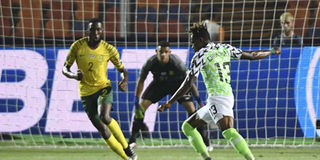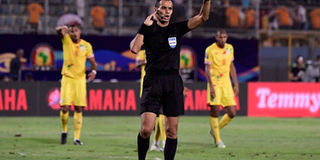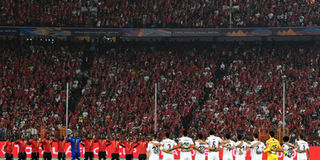A memorable Afcon is done and dusted, now fast forward to the future

Nigeria's forward Samuel Chukwueze (right) attempts a shot during their 2019 Africa Cup of Nations quarter-final match against South Africa at Cairo international stadium on July 9, 2019. PHOTO | KHALED DESOUKI |
What you need to know:
- It was the first to have a round of 16, the number of competing teams having been raised to 24.
- It was also the first to use the services of the Video Assistant Referee (VAR), albeit from the quarter-final stage.
By the time you read this, you will already have known whether the 2019 Africa Cup of Nations will be on its way to Dakar or Algiers. The dictates of time meant I couldn’t have written my wrap-up any later. Regardless, I still feel confident enough to dish out my bouquets - and barbs - for what I think was one of the more memorable tournaments in the 62-year history of the competition.
It was the first to have a round of 16, the number of competing teams having been raised to 24. It was also the first to use the services of the Video Assistant Referee (VAR), albeit from the quarter-final stage.

Algerian referee Mustapha Ghorbal whistles for VAR during the 2019 Africa Cup of Nations quarter-final match between Senegal and Benin at the 30 June stadium in Cairo on July 9, 2019. PHOTO | JAVIER SORIANO | AFP
Both of these make for my first point:
Innovation. There are people who said a tournament of 24 would water down the quality of competition. New entrants, they argued, would just become whipping boys for the established teams. I am sure they revised this opinion after watching Madagascar and Benin. Both saw off Nigeria and Morocco respectively.
Time does not stand still. There were four teams in the inaugural Afcon in 1957. It couldn’t stay like that forever. The steady increase has been the natural consequence of new Caf-member countries and the viewers that come with that and improvements in mass communication. Twenty four is not the ceiling; it will go higher still in the future.
I have not been able to understand the people who have issues with VAR. To me, it is one of the greatest innovations in football, probably the greatest after the introduction of the whistle and the card. It was, in fact, long overdue. Consider the case of the semi-final match between Senegal and Tunisia.
Ethiopian referee Bamlak Tessema unhesitatingly awarded Tunisia a penalty on the grounds of what he saw as a clear handball but on reviewing the evidence of the VAR, he reversed his own decision. Watching the replay, it was obvious his second call was correct. What an injustice had his original decision stood.
I for one have never disagreed with a VAR decision since the technology was introduced during last year’s Russia World Cup.
Revelation of the tournament. By a mile it was Nigeria’s 20 year-old wonder-boy, Samuel Chukwueze, the youngest player in the competition. I couldn’t have enough of him. His ball control skills, his blinding acceleration, the accuracy of his long range passes all made me long to watch the matches of the Super Eagles. His combination with Ahmed Musa on the opposite wing and Odion Ighalo in the centre made for the liveliest attack in the competition but which, unfortunately, was let down by leakages at the back.
When they lost to Algeria, I missed them for the final. Chukwueze has been quoted as saying: “We have a strong team with young and talented players. We are going to do well in the future. I think that in the next two years we are going to be the favourites to win the Nations Cup. There are so many talented players in this team.” I agree and I am going to be keeping track of him.
Best goalkeeper of the tournament. I won’t hesitate to give this one to Denis Onyango of the Uganda Cranes. He just wasn’t playing for a stronger team otherwise he is Cup final material. The man mountain is so agile you wonder how he does it. But he embodies what I think is the gradual return of Uganda Cranes to top flight football. It has been a long journey from the days of the 1970s. I have this feeling the Cranes have finally put their act together and will be regular campaigners in Afcon – after sorting out allowances issues, of course.

Uganda's goalkeeper Denis Onyango during their 2019 Africa Cup of Nations match against DR Congo at Cairo International Stadium on June 22, 2019.
The organisation. I am going to leave this to my worthy colleague, Charles Nyende who, by being there from Day One, knows where the shoe pinches. But looking at the meticulously maintained changing rooms, I couldn’t help remembering the flooded Safaricom Stadium during the last rains.
The ghastly images reminded me of a book I read about guerrillas in a makeshift tent in the jungles of the Sierra Maestra mountains in Cuba during a heavy downpour. One fighter bet his comrade that it was raining heavier inside the tent than outside. Watching those images, I think it was also the case with Kenya’s best international stadium.

Players and officials observe a minute of silence ahead of the 2019 Africa Cup of Nations Group A match between Uganda and Egypt at the Cairo International Stadium in the Egyptian capital on June 30, 2019. PHOTO | KHALED DESOUKI |
And talking of our man in Cairo, from what I read in one of his chronicles, I hope he was able to facilitate the sale of an aeroplane to his Nigerian friend. Commissions on aeroplane sales are very good.
Lessons learnt. It remains very hard to gatecrash a big boys’ party. Ask Namibia. Their coach said as much. He said Afcon is not the kind of place you make schoolboy errors and get away with it. Even Madagascar and Benin, for all their enterprise, still learnt the hard way that they had strayed into a private members’ club. Former winners have a habit of repeating their wins. Harambee Stars, with your dodgy visa applications for ‘fans/players’, stay warned.
**** **** *****
They will lay Joe Kadenge to rest on Sunday. Among the responses I have received to the tributes Nation Sport has published since his death is this one from Edward Kedogo, his former player:
“Joe was my coach in 1968 when I played for Tiriki FC together with Antony Mukabwa. Later he became my team manager when I was playing for Maragoli United FC from 1975 to 1981. He was one of the best managers in football. He was very good in poaching players from other clubs - even outside Kenya’s boundaries. I always remember when he signed Polly Ouma and Nassur Abbey in Kakamega Refugee Camp where they were staying after having escaped from Uganda when Idi Amin was deposed as president. It’s unfortunate we have lost such a great person. It will take years to get a replacement who will fit in his shoes. My heart goes out to his family.” He attached a team photograph of Maragoli FC in 1979.
The events in Kenya and Uganda after Idi Amin was toppled in 1978 helped illuminate for us the heart of Joe Kadenge. Who was he the man and not just the footballer? In a previous column I had written about Abbey Nasur, the man Kedogo was talking about. His description of events must feature in any life story written about Kadenge.
Briefly, the former Uganda Cranes winger, who helped his country to a silver medal in the 1978 Africa Cup of Nations, suddenly found himself a refugee in Kenya. In the fallout after Amin’s flight to exile, any member of the country’s armed services became a marked person. Nasur, a prisons officer, was one such. It was also his misfortune to share an ethnic background with Amin. That sealed his fate.
“If you had been a policeman, soldier or prisons officer,” Nasur told me, “you became marked as Amin’s askari. I had never contemplated leaving Uganda but my wife frantically said to me: ‘We are not safe. The children are not safe. We must flee.’”
Nasur put his family of five in his car and drove all the way to Kibra, to his mother’s house. At the border, he had been waved off by friendly Kenyan immigration officers who recognised him. But Kenya was awash with Ugandan refugees and the government mounted a massive operation to ship them back home.
Nasur’s Uganda-registered vehicle was a dead giveaway. He was arrested and carted off to Kakamega show ground, the holding ground for people about to be sent back home. After a week of his stay at the showground and certain that he would be repatriated, he heard that there was a man frantically looking for him. He carried with him a letter, which he said was from the Western Provincial Commissioner.
Nasur was at first scared of stepping forward, unsure who this man was. But after some agonising hesitation, he decided to take his chances. The man turned out to be Joe Kadenge, the famous Kenya football legend. He didn’t know Kadenge personally but like everybody else in East Africa then, he had heard of him.
There was an immediate rapport between Nasur and Kadenge both of whom played on the rightwing of the football field. And for the Ugandan with partial Kenyan roots, the appearance of Kadenge and what he did thereafter was akin to living through a beautiful dream.
Kadenge was then the team manager of Maragoli FC. He talked the provincial administration into releasing Nasur, rented a house for him in Kibera and gave him a place in Maragoli FC. And he made sure that Nasur and his family never ran out of food.
“I will never be able to thank Joe Kadenge enough for as long as I live. To this day, I am overwhelmed with gratitude each time I remember what he did for me. I played for Maragoli for two seasons and I helped nurture players like Wilberforce Mulamba and Francis Kadenge, Joe’s son. But I don’t know what I will ever do for Joe. He treated me with a kindness more than the most loving father could.”
I hope these are the kinds of stories mourners will hear today. But I have my doubts. Kenya has one of the most obnoxious social practices in the world – politicking over the bodies of the dead in callous disregard for the feelings of grieving relatives. I hope it is the remembrances of old team mates and the sentiments of family and friends who were with him for most of the days of his 84 years in this world that we shall hear. Certainly not political skulduggery ahead of 2022 on this occasion. But, of course, I am wrong.
And knowing Joe as I did, I am sure he would much appreciate if it was a revamped Nairobi City Stadium, rather than Nyayo National Stadium, that he would prefer named after him. That is where he displayed his legendary magic. It would make him smile up there. Go well, good man.





